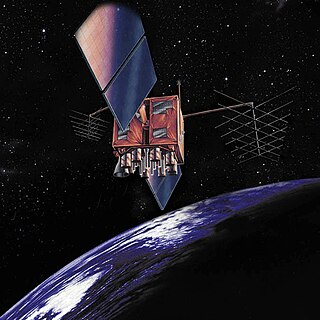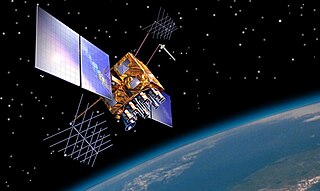USA-35, also known as Navstar 2-01, GPS II-1 and GPS SVN-14, was an American navigation satellite which formed part of the Global Positioning System. It was the first of nine Block II GPS satellites to be launched, which were the first operational GPS satellites to be launched.
USA-38, also known as GPS II-2 and GPS SVN-13, was an American navigation satellite which formed part of the Global Positioning System. It was the second of nine Block II GPS satellites to be launched, which were the first operational GPS satellites to be launched.
USA-42, also known as GPS II-3 and GPS SVN-16, was an American navigation satellite which formed part of the Global Positioning System. It was the third of nine Block II GPS satellites to be launched, which were the first operational GPS satellites to be placed into orbit.
USA-49, also known as GPS II-5 and GPS SVN-17, was an American navigation satellite which formed part of the Global Positioning System. It was the fifth of nine Block II GPS satellites to be launched, which were the first operational GPS satellites to fly.
USA-50, also known as GPS II-6 and GPS SVN-18, was an American navigation satellite which formed part of the Global Positioning System. It was the sixth of nine Block II GPS satellites to be launched, which were the first operational GPS satellites to fly.
USA-63, also known as GPS II-8 and GPS SVN-21, was an American navigation satellite which formed part of the Global Positioning System. It was the eighth of nine Block II GPS satellites to be launched, which were the first operational GPS satellites to fly.
USA-64, also known as GPS II-9 and GPS SVN-15, was an American navigation satellite which formed part of the Global Positioning System. It was the last of nine Block II GPS satellites to be launched, which were the first operational GPS satellites to fly. It was also the last Block II satellite to be retired from service.
USA-84, also known as GPS IIA-6, GPS II-15 and GPS SVN-27, is an American navigation satellite which forms part of the Global Positioning System. It was the sixth of nineteen Block IIA GPS satellites to be launched.
USA-88, also known as GPS IIA-9, GPS II-18 and GPS SVN-22, was an American navigation satellite which formed part of the Global Positioning System. It was the ninth of nineteen Block IIA GPS satellites to be launched.
USA-90, also known as GPS IIA-10, GPS II-19 and GPS SVN-31, was an American navigation satellite which formed part of the Global Positioning System. It was the tenth of nineteen Block IIA GPS satellites to be launched.
USA-91, also known as GPS IIA-11, GPS II-20 and GPS SVN-37, was an American navigation satellite which formed part of the Global Positioning System. It was the eleventh of nineteen Block IIA GPS satellites to be launched.
USA-92, also known as GPS IIA-12, GPS II-21, GPS SVN-39, and NAVSTAR 39, is an American navigation satellite which forms part of the Global Positioning System. It was the twelfth of nineteen Block IIA GPS satellites to be launched.
USA-100, also known as GPS IIA-15, GPS II-24 and GPS SVN-36, is an American navigation satellite which forms part of the Global Positioning System. It was the fifteenth of nineteen Block IIA GPS satellites to be launched.
USA-126, also known as GPS IIA-17, GPS II-26 and GPS SVN-40, is an American navigation satellite which forms part of the Global Positioning System. It was the seventeenth of nineteen Block IIA GPS satellites to be launched.
USA-128, also known as GPS IIA-18, GPS II-27 and GPS SVN-30, is an American navigation satellite which forms part of the Global Positioning System. It was the eighteenth of nineteen Block IIA GPS satellites to be launched.
USA-135, also known as GPS IIA-19, GPS II-28 and GPS SVN-38, is an American navigation satellite which forms part of the Global Positioning System. It was the last of nineteen Block IIA GPS satellites to be launched.

USA-132, also known as GPS IIR-2 and GPS SVN-43, is an American navigation satellite which forms part of the Global Positioning System. It was the second Block IIR GPS satellite to be launched, out of thirteen in the original configuration, and twenty one overall. GPS IIR-1 failed to achieve orbit, so USA-132 was the first successful Block IIR satellite. It was built by Lockheed Martin, using the AS-4000 satellite bus.

USA-150, also known as GPS IIR-4 and GPS SVN-51, is an American navigation satellite which forms part of the Global Positioning System. It was the fourth Block IIR GPS satellite to be launched, out of thirteen in the original configuration, and twenty one overall. It was built by Lockheed Martin, using the AS-4000 satellite bus.

USA-175, also known as GPS IIR-10 and GPS SVN-47, is an American navigation satellite which forms part of the Global Positioning System. It was the tenth Block IIR GPS satellite to be launched, out of thirteen in the original configuration, and twenty one overall. It was built by Lockheed Martin, using the AS-4000 satellite bus.

USA-203, also known as GPS IIR-20(M), GPS IIRM-7 and GPS SVN-49, is an American navigation satellite which was intended to become part of the Global Positioning System. It was the sixth of seven Block IIRM satellites to be launched, and the twentieth of twenty one Block IIR satellites overall. It was built by Lockheed Martin, using the AS-4000 satellite bus, and had a mass of 2,032 kilograms (4,480 lb).

